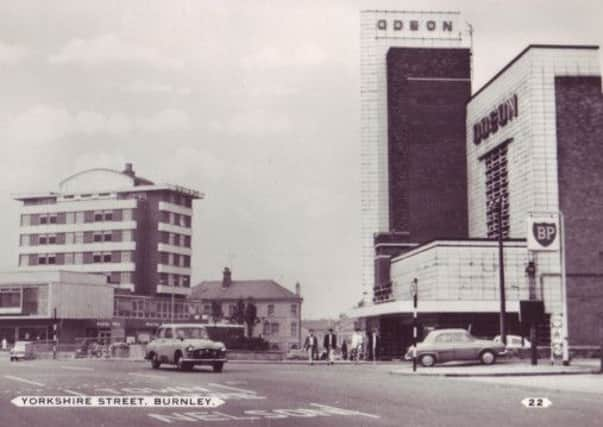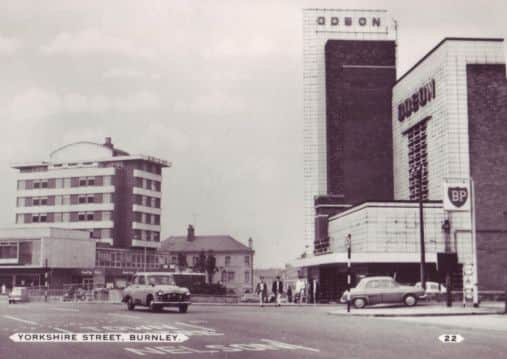The many cinemas of Burnley’s past


I have to admit I have never been a film buff. I put that down to my mother who, because we lived in Harle Syke, was of the opinion the bright lights of Burnley’s picture houses were too far away for us to make our way there by ourselves.
Consequently, my early film memories, such as they are, do not consist of “Flash Gordon” movies at the Odeon or the Saturday children’s films shown at the Palace or Empire. My memories commence with the sober experience of seeing a black and white film about the life of St Bernadette! My classmates, and myself, had been taken on a coach (the only time I saw a coach anywhere near school) to the Palace by the nuns of St John’s in Ivy Street.
Advertisement
Hide AdAdvertisement
Hide AdThis might have been radical for the 1950s but it was not “Flash Gordon”. I had to wait until a film was televised before I saw it. My parents realised the significance of television at an early date, 1953, in fact, the Coronation year. My father bought a 9in. Pye which made our house the most popular in the street, until the Tattersalls got ITV and we all went round there. My mother was one of the beneficiaries of this change in fortune, but I am not sure what Mrs Tattersall thought.


Our television had a large, chemically-filled magnifying glass, with stand, in front of the set. It made the screen look a lot larger but it was still only about 14in. and, in any case, it was not all that long before I had contrived to break the glass. Its liquid contents spilled all over the carpet and a dark stain, which could not be removed, remained in the corner of the front room as a daily reminder of my folly.
However, television, rather than the cinema, was my introduction to the world of film. The same applied to the older of my brothers and sisters and it was something friends and relations could not understand, especially Dad’s side of the family because some of his relations were quite big in film and worked in Wardour Street, W1, at the time the centre of the British Film Industry.
Oh, the answer I gave to the journalist was ... “David Niven, Kim Hunter, Roger Livesey and Raymond Massey, in ‘A Matter of Life and Death’. The film was released in 1947. It is often regarded as the second best British film ever made, after “Get Carter”, but, for me, it is the best. The film is a romantic fantasy which is set in England during the Second World War.
Advertisement
Hide AdAdvertisement
Hide AdIn America the film was known as “Stairway to Heaven” after its most prominent special effect, a broad escalator linking Earth to the after-life. This was one of the features of the film which appealed to me. Another was that all the scenes in the Other World were in black and white but those on Earth were in a vivid colour.
The storyline was a clever one and the actors were perfectly cast. I was particularly impressed by Abraham Sofaer, who took the part of the God-like Judge, who had to hold an inter-galactic court which would decide whether David Niven’s character would be allowed to live or die.
I ought to add I have not seen the film in a cinema but have to admit that, whenever it is shown on TV, I go out of my way to find time to watch it. In fact my visits to Burnley cinemas are limited to the Odeon (three times), the Palace (once) and Empire (once). In my university days I attended a few performances in Manchester and, when I came back to Burnley (by which time there was no cinema in town, although a chain was based here) I went to Unit 4 in Brierfield, perhaps twice.
From this it can be seen my experience of Burnley’s cinemas is pretty limited and this is from someone whose grandfather lived next door to the Tivoli in Colne Road! In all the years he lived there, behind his shop, I never saw a film at the Tivoli. I did go in once, to deliver something to the manager, but, to me at least, it was an eerie place without an audience and the experience probably added to my ambivalence about cinemas.
Advertisement
Hide AdAdvertisement
Hide AdHowever, I do understand how important they were to large numbers of Burnley people over the years. I suppose 1941 must have been the peak for “going to the pictures” in Burnley. In that year there were 15 “theatres, picture and music halls” in town with others in Padiham. Of these, all were capable of showing films but, at this time, at least one, the Victoria, was primarily a theatre rather than a cinema. It was in this capacity I visited the Victoria when, as boy, I saw a pantomime, “Babes in the Wood”, I think. It was my first visit to the theatre.
The cinemas were divided between those located in the town centre and those that served local communities. In 1941 the split was seven in the town centre (the Empire, Grand Super, Odeon, Palace, Savoy, Temperance Hall and Victoria) and eight elsewhere. These latter were, the Alhambra (Trafalgar Street), the Coliseum (Gannow Lane), the Empress (Sandygate), the Imperial (Redruth Street), the Kings (Thorn Street, off Hebrew Road), the Pentridge (Holmes Street), the Royal (Robinson Street) and the Tivoli (Colne Road).
Of course, this list is not complete as it includes only those cinemas active in 1941. Lots of other buildings have been used for the showing of films - including the Mechanics, the Church Institute, the Roxy, Majestic (formerly the Stoneyholme Picturedrome), Pavilion and Studios 1 and 2 in the modern Market Square. Then there were more on top of that!
Let us tour some of Burnley’s cinemas with a series of images owned by the Briercliffe Society. Most of the pictures come from postcards but I have included at least one photo.